#david getsy
Explore tagged Tumblr posts
Text
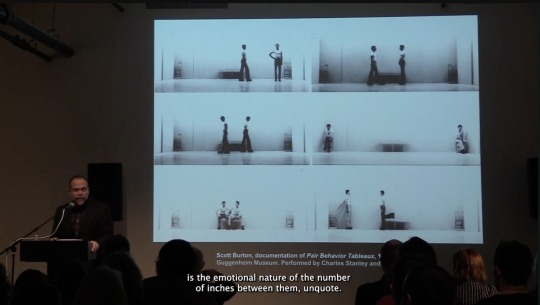
Before he started making chair-like sculptures, Scott Burton made theater-like performance art that centered the public and private physical experience of queerness in the dominant heteronormative culture. His Behavior Tableaux were sets of precisely choreographed movements based on the body language, power dynamics, and covert communication of street cruising.
David Getsy has spent twenty years researching and interviewing to produce the first monograph of Burton's work, which he discussed at Artists Space in Dec. 2023 after the book won an award from the Dedalus Foundation.
#scott burton#david getsy#artists space#performance art#what I want people to become aware of is the emotional nature of the number of inches between them
9 notes
·
View notes
Text
Everybody in academia insists on using queer and i dont really like it that much, but I've just been stockhold syndromed into using it.
#the reason is certain ppl who talk about it piss me off otherwise im fine with it#its a an easy reclaimed umbrella term now whatever#also i like queer abstraction a lot#loved david getsys essay on it
0 notes
Text
The Leader of a Queer Generation; The Rocky Horror Picture Show

(This is another college essay we are posting for funzies lmao, enjoy!). (Also had to censor it, sorry!).
With the fall of the Hays Code, the queer demographic was finally able to have their own cult classics and media culture. Most prominently was The Rocky Horror Picture Show (Richard O’ Brien) in 1975. For a bit of history. The Hays Code was in effect from 1934-1968. The Hays Code was a rigid set of rules for television and film that stated all delinquent behavior must be punished on screen. If a character did something immoral, they must suffer the consequences, the consequence usually being death. The Hays Code itself outlined what it deemed to be immoral behavior. Among that list was anything remotely queer. This is where many tropes and writing tools were developed such as the “Burry Your Gays” trope or queer coding. The Hays Code was lifted in 1968 and replaced with something similar to our rating system today. So, what did that mean for queer audiences? It meant it was time for them to be the stars!

For the first time in decades showrunners and movie makers could show queer activity on the small or even big screen! The most notable product of this time period was The Rocky Horror Picture Show. Originally a musical performed onstage in the early 70s that was adapted into a film in 1975. The original musical and movie shared a similar cast, most notably Tim Curry as the main antagonist Frank-N-Furter. Frank was a self described “Sweet Transvestite from Transexual Transylvania” (O’ Brien 1975). The word transvestite was very different than what it means today. In 1975 it was equivalent to Frank telling the characters Brad and Janet (but also the audience) that he was transexual or transgender (as those terms were not in frequent use until much later).

Speaking of Brad and Janet, they are the audience’s “straight man”. To quote David J Getsy “One cannot be queer alone” (Getsy, 2017, para. 2). This is to use the original meaning of the word “queer” as in weird. You cannot be weird if there is no normal, so Brad and Janet are the stand ins for an average American straight couple. Throughout the movie though we see Brad and Janet start to learn things about themselves at Frank’s castle. After Frank has s*x with each of them separately they start to see things differently. Janet becomes more open and lustful with her sexuality making many advances towards titular character Rocky. Janet is also seen making out with another girl, Columbia. Brad while less confident, still learns some preferences he did not know he had that can be considered “out of the norm”. Another popular reading being he was a closeted gay man as well. Brad and Janet learn with the audience that it is ok to explore one’s sexuality and gender identity. While Frank-N-Furter does in fact die, the Hays Code still has no effect here as Brand and Janet get to live out their lives after their newfound discoveries.

Brad and Janet aren’t the only ones who have a good time in the castle. In the “Time Warp” the audience along with Brad and Janet are introduced to Riff Raff and Magenta, a quirky sibling duo. Later in the song the character Columbia introduces herself. She tells the story of how she met Frank-N-Furter and how he changed her life. Later in the movie we are also introduced to Eddie and Rocky. Eddie being a former lover of Frank and Columbia’s. Rocky is the man Frank-N-Furter makes, very Frankenstein esq. In the song “Rose Tint My World” each character performs in a floor show expressing how Frank’s lust and freedom has rubbed off on them. Some like Brad and Columbia have their reservations but choose to wear those rose tinted glasses, while Rocky and Janet are completely accepting of this new found life. Eventually the evening is cut short when Riff Raff kills Frank as well as Rocky and Columbia. Riff Raff does this as he proclaims Frank-N-Furter’s lifestyle was just “too extreme (O’ Brien, 1975).

Just like Brad, Janet, and everyone else in the castle, the real world also has a tradition inspired by Frank-N-Furter (and The Rocky Horror Picture Show). Performance groups acting along side showings of the movie become vastly popular. As did a script of “counterpoint dialogue” the audience would shout during the movie. It was also tradition to throw toilet paper at the screen during certain scenes in the movie (although this one has fallen out of fashion at some theaters, being deemed “rude”). For these events the audience can dress however they want! The idea was to be comfortable and be yourself. This means many people show up in similar fashion to the movie. Gothic, gram rock, corsets, you name it! It is a night of community and fun.

In 2016 The Rocky Horror Picture Show was remade as a filmed stage musical titled The Rocky Horror Picture Show: Let’s Do The Time Warp Again (Kenny Ortega, 2016). In this production, actress Laverne Cox was casted as Frank-N-Furter. Cox is a transwoman, marking the first official time Frank-N-Furter was played by an actual transwoman. Laverne Cox is also African American and finally sheds some light on black queers in this production, something sorely lacking in the original production. There are stark differences in the interpretations of the character Curry and Cox portrayed. The outfitting of Tim Curry’s Frank-N-Furter implies shock value by using feminine clothing to show off a masculine body, while Laverne Cox’s costuming is more feminine in nature. Cox’s Frank-N-Furter is still compared to the “straight men” of Brad and Janet but not in an oppositional nature.
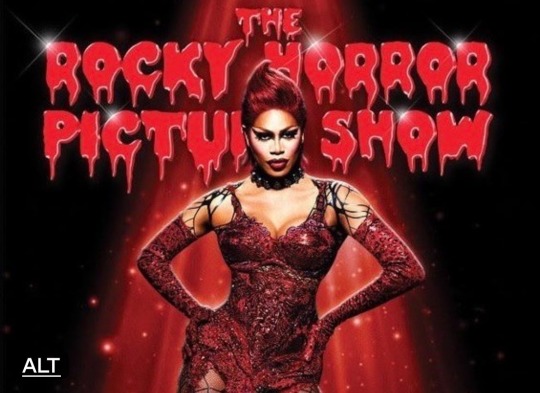
The influence of The Rocky Horror Picture Show still goes on today. There are still many notable screenings of the movie with live actors and scripted audience responses. The 2016 remake was just one production of many put on through the years. Popular media nowadays even references The Rocky Horror Picture Show. Even in places you wouldn’t expect such as kids shows like Phineas and Ferb (Dan Povenmire and Jeff Marsh, 2007). The Rocky Horror Picture Show introduced an audience to queer culture and continues to be a part of said culture many decades later. The way in which this movie carried itself into queer culture signifies its strong se of rhetorical devices such as; ethos, logos, and pathos. The ethos present in the film is that of Frank (who has experience) showing the characters AND the audience how happy they’d be to give into desire and to simply be themselves. This ties into the logos being that these characters do in fact end up happy in their newfound situation, especially Janet. The pathos plays on the fact that all humans have some sort of desire they push down. The Rocky Horror Picture Show uses these literary devices to tell its queer audience for generations to be themselves and have fun!

#Am so done with egos logos and pathos#It ruins the flow of the essays#The Rocky Horror Picture Show#Queer#LGBTQ#Rocky Horror Picture Show#RHPS#Frank N Furter#Brad Majors#Janet Weiss#Columbia RHPS#Riff Raff#Magenta RHPA#Eddie RHPS#Rocky RHPS
30 notes
·
View notes
Text
That intro by a one, David J. Getsy attributing gender nonconformity or drag to one group rather than being a global practice utilized at different times for different purposes. Strikes me as ahistorical and ignorant. What I'm saying is: He's wrong.
1 note
·
View note
Text

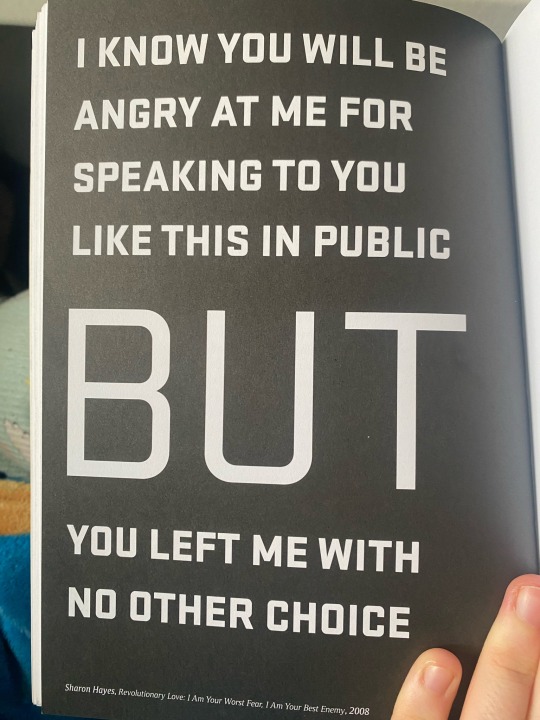
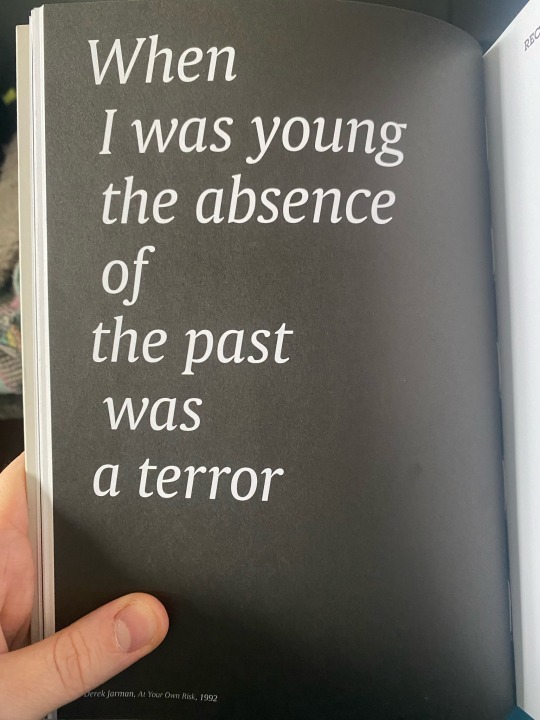

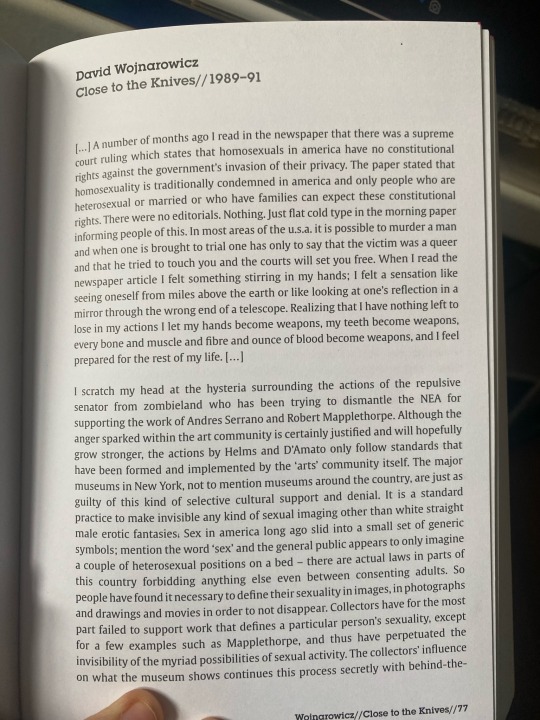

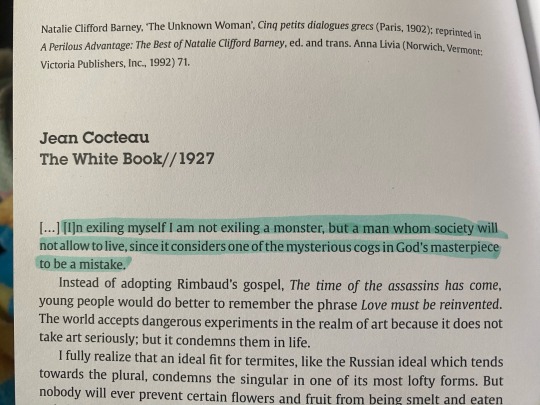
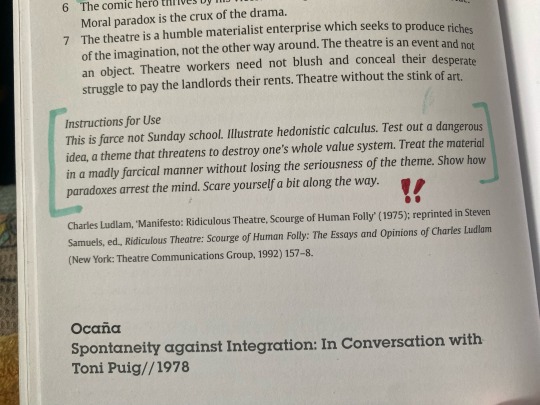

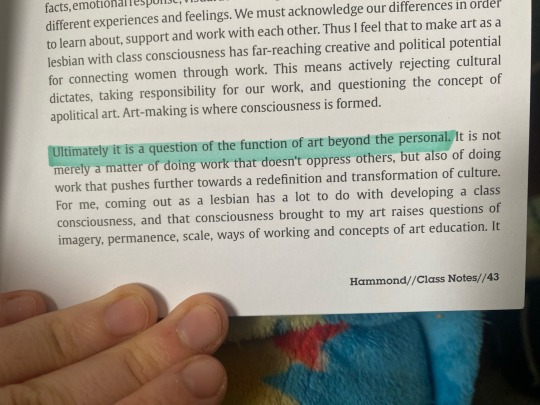
EASTER BREAK: Documents of Contemporary Art: Queer. Per my tutor’s suggestion, I picked up a copy of “Documents of Contemporary Art: Queer” by David J. Getsy at the beginning of the Easter break, and have been reading it since. I have currently finished the first section, “Recognising Backwards” and am now in the process of reading the “Public Rage” section. So far, this book is nothing short of incredible: it’s powerful look into 19th/20th century queer perspectives once thought forgotten is a fascinating look into the history of gay lives on an individual and societal scale, and the anger and pain is felt tenfold in the “Public Rage” section, especially surrounding the gruelling times of the AIDS crisis of the 1980s-2000s. I have been highlighting my favourite quotes and photographing my favourite sections: so far, my favourite piece featured in the book has been painter and photographer David Wojnarowicz’s “Close to the Knives”, where David shares his burning rage about the lives lost during the AIDS crisis, his experience of marginalisation as a gay man and coming to terms with his own diagnosis of AIDS. This section was quite frankly enraging and horrifying to read, and that’s why I loved it: it’s enraging for queers and a bitter truth to face for heterosexuals. That’s sort of the tone I want to achieve with my own novel, only more aimed at teenagers/young adults. Absolutely loving this book’s lessons on queer culture, art and audience. Hope to continue reading and learning from this collection of queer creators.
0 notes
Text
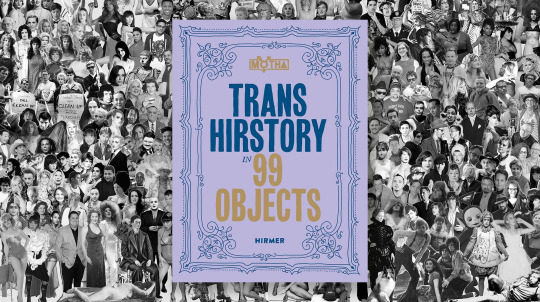
This was a pleasure to copy edit and proofread. Go get your copy now.
TRANS HIRSTORY IN 99 OBJECTS
Eds. David Evans Frantz, Christina Linden, Chris E. Vargas
Surveying over four centuries, this volume brings together a wide-ranging selection of artworks and artefacts that highlight under-recognised histories of trans and gender-nonconforming communities. Through the contributions of artists, writers, poets, activists, and scholars, this title reflects on historical erasure to imagine trans futures.
Contributions by K. Bornstein, R. Brodell, V. Davis, L. DeVun, M. B. Dick, Z. Drucker, D. Getsy, M. Gutierrez, A. Jenkins, J. Guarano Kuriki-Olivo (Puppies Puppies), T. (T.) Jean Lax, A. J. Lewis, M. A. López, A. Mac, C. Metzger, D. A. Miranda, M. M. Page, SA Smythe, C. Riley Snorton, D. Spade, S. Stone, J. Tang, M. Tea, McKenzie Wark u. a.
304 pages, 287 colour illustrations 19.4 x 25.4 cm, softcover
0 notes
Video
vimeo
Viral Representation: On AIDS and Art by David Getsy
108 notes
·
View notes
Photo

To commemorate the centennial of August Rodin's death, art historian David Getsy discusses the sculptor’s themes of sexuality and love, and explores how they influenced his reputation and development as a modern artist. Join us on Friday, Nov 17, for the Roz Perry Memorial Lecture: Exhibiting Intimacy: Rodin, Sex & Modern Sculpture in the Perelman Building. $20 (free for members); includes Museum admission
"Eternal Springtime," modeled 1884; cast between 1898-1918, Auguste Rodin
#August Rodin#Rodin Museum#Rodin Museum Philadelphia#Rodin sculpture#Rodin 100#Rodin#art#art museum#museum#art history#history#calendar of events#art talk#art conversations#Eternal Springtime#David Getsy#art historian
56 notes
·
View notes
Photo
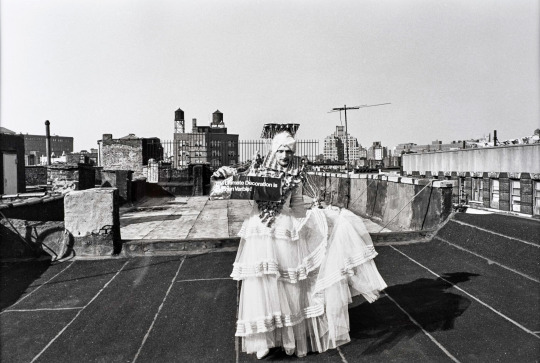
During the golden age of downtown performance art in the 1970s, Jimmy DeSana documented the work of numerous artists, sometimes for income.
In 1975, he photographed public interventions by Stephen Varble, an artist who performed his “Gutter Art” in the streets of Soho and Midtown, while wearing his signature gender-bending ensembles. As the critic Gregory Battcock put it, Varble came to be “considered by some the embarrassment of SoHo, and by others the only touch of real genius south of Houston Street.” DeSana’s photographs of Varble appeared in publications during this time, including General Idea’s FILE Megazine.
DeSana’s photographs are invaluable records of an ephemeral practice, which has only recently been given its proper due thanks in part to the work of art historian David Getsy. #JimmyDeSanaBkM
📷 Jimmy DeSana (American, 1949–1990). Stephen Varble, 1975. Gelatin silver print. Courtesy of the Jimmy DeSana Trust and P·P·O·W Gallery, New York. © Estate of Jimmy DeSana. (Photo: Allen Phillips)
#Brooklyn Museum#brooklyn#museum#art#Jimmy DeSana#JimmyDeSanaBkM#exhibition#photography#nyc#New York City#Stephen Varble#SoHo#nyc history
39 notes
·
View notes
Photo

In 2014, tech leader and burgeoning art collector Komal Shah's "eyes were opened to what she described as vast inequities faced by women artists in market prices, museum acquisitions and overall visibility in the art world." She has since assembled one of the most notable collections in America. "Made predominantly by generations of women working in abstraction, from the mid-20th-century artists Joan Mitchell and Lenore Tawney to the young contemporary painters Firelei Báez and Jadé Fadojutimi, the collection isn’t obviously about gender. Rather, it embodies a feminist perspective through its bold expressiveness." Read more about Ms. Shah, the collection and the superb forthcoming 432-page catalog, 'Making Their Mark: Art by Women in the Shah Garg Collection,' in this @nytimes feature by @hilariesheets via linkinbio 'Making Their Mark: Art by Women in the Shah Garg Collection' is published by @gregoryrmiller Edited with text and interview by Mark Godfrey, Katy Siegel. Text by Daniel Belasco, Glenn Adamson, David J. Getsy, Kirsty Bell, Jessica Bell Brown, Gloria Sutton, Kevin Beasley, Charles Gaines, Lyle Ashton Harris, Jacqueline Humphries, Allison Katz, Helen Marten, Laura Owens, Tschabalala Self, Christina Quarles, Jaune Quick-to-See Smith, Joyce J. Scott, Kay Sekimachi, Mary Weatherford, Aria Dean, Kay WalkingStick. @komalshahgarg @markgodfrey1973 @katysiegel.88 #makingtheirmark #shahgarg #shahgargcollection https://www.instagram.com/p/CqGFkuRuFp6/?igshid=NGJjMDIxMWI=
1 note
·
View note
Text

im reading manifestos compiled by spit! U_U this one is called 'refusing ambiguity' and its by david j getsy
2 notes
·
View notes
Text
R.I.P. (Rest in PDFs), Part I
in progress ...
Part II (N-Z) is here.
Also visit the PDF branch of the Hiroshima Library
Note: If you see your work on here and prefer that it not be made freely accessible, please email me at: [email protected], and I will remove it. Thank you!
+++++++++++++++++++++++++++++++++++++++++++++++++++++++++++
Achille Mbembe, Necropolitics. Translated from the French by Libby Meintjes.
Achille Mbembe, The Power of the Archive and its Limits. Translated from the French by Judith Inggs
Adrienne Rich, Woman and Honor: Some Notes on Lying
Aimé Césaire, Discourse on Colonialism. Translated from the French by Joan Pinkham.
Aimé Césaire, Letter to Maurice Thorez. Translated from the French by Chike Jeffers.
Aimé Césaire, Notebook of a Return to the Native Land. Translated from the French by Clayton Eshleman and Annette Smith
Alexis Pauline Gumbs, the introduction to M Archive: After the End of the World
Alex S. Vitale, The End of Policing
All Monuments Must Fall: A Syllabus, created/crowd-sourced by Nicholas Mirzoeff and many others
Amilcar Cabral, Return to the Source: Selected Speeches
Amy Uyematsu, The Emergence of Yellow Power
Andaiye, Counting Women’s Caring Work: an interview with David Scott
Angela Davis, Abolition Democracy: Beyond Empire, Prisons, and Torture
Angela Davis, Are Prisons Obsolete?
Angela Davis, Racialized Punishment and Prison Abolition
Angela Davis, Women, Race, Class
Angel Dominguez, Black Lavender Milk
Angie Morrill, Eve Tuck, and the Super Futures Haunt Qollective, Before Dispossession, or Surviving It
Anne Anlin Cheng, The Melancholy of Race
Anne Anlin Cheng, Ornamentalism: A Feminist Theory for the Yellow Woman
Anne Boyer, No, from A Handbook of Disappointed Fate
Antonio Gramsci, The Gramsci Reader: Selected Writings 1916-1935
Asian American Feminist Antibodies {care in the time of coronavirus}, a zine by Asian American Feminist Collective, in collaboration with Bluestockings NYC,
Assata Shakur, Assata: An Autobiography
Audra Simpson, On Ethnographic Refusal: Indigeneity, ‘Voice’ and Colonial Citizenship
Audre Lorde, I Am Your Sister: Black Women Organizing Across Sexualities
Audre Lorde, Poetry is Not a Luxury
Audre Lorde, The Transformation of Silence into Language and Action
Audre Lorde, The Uses of Anger
Aufgabe, Number 4, Fall 2004, feat. Japanese poetry in translation guest edited by Sawako Nakayasu
Aufgabe, Number 13, 2014, feat. poetry in translation from India guest edited by Biswamit Dwibedy & a special section of poetry from the Moroccan journal Souffles
Bayard Rustin, “Black Power” and Coalition Politics
bell hooks, all about love: New Visions
bell hooks, Black Looks: Race and Representation
bell hooks, Feminism Is For Everybody: Passionate Politics
bell hooks, Feminist Theory from margin to center
bell hooks, Teaching to Transgress: Education as the Practice of Freedom
Benedict Anderson, Imagined Communities: Reflections on the Origin and Spread of Nationalism
Bhanu Kapil, Reading Lauren Berlant in the Bath
C.L.R. James, The Black Jacobins: Toussaint L’Ouverture and the San Domingo Revolution
Calvin Warren, Black Care
Calvin Warren, the introduction to Ontological Terror: Blackness, Nihilism, and Emancipation
Carrie Lorig, The Book of Repulsive Women: Five Increasing / Rhythms
Cathlin Goulding, Walking the Places of Exception: The Tule Lake National Monument
Cathy Caruth, Unclaimed Experience: Trauma, Narrative, and History
Cedric Robinson, Black Marxism: The Making of the Black Radical Tradition
Chandra Talpade Mohanty, Under Western Eyes: Feminist Scholarship and Colonial Discourses
Chela Sandoval, Methodology of the Oppressed
Christina Sharpe, Kara Walker’s Monstrous Intimacies (from Monstrous Intimacies: Making Post-Slavery Subjects)
Christina Sharpe, The Wake (the first chapter of In the Wake: On Blackness and Being).
Claudia Jones, An End to the Neglect of the Problems of the Negro Woman
David J. Getsy and Che Gossett, A Syllabus on Transgender and Nonbinary Methods for Art and Art History
David L. Eng, The Value of Silence
Denise Ferreira da Silva, On Difference Without Separability
Denise Ferreira da Silva, Toward a Black Feminist Poethics
Denise Ferreira da Silva, Toward a Global Idea of Race
Diana Taylor, The Archive and the Repertoire: Performing Cultural Memory in the Americas
Diane di Prima, Revolutionary Letters
Dionne Brand, An Ars Poetica from the Blue Clerk
Divya Victor, Ten Little Poets
Divya Victor, from Things To Do With Your Mouth
Dot Devota, T H E D O G W O O D S
dusie 19: The Asian Anglophone issue (edited by Cynthia Arrieu-King)
Édouard Glissant, Caribbean Discourse: Selected Essays. Translated from the French by J. Michael Dash.
Eduardo Galeano, Open Veins of Latin America: Five Centuries of the Pillage of a Continent. Translated from the Spanish by Cedric Belfrage
Edward Said, Culture and Imperialism
Edward Said, Orientalism
Edward Said, Out of Place: A Memoir
Edward Said, Permission to Narrate
Edward Said, Reflections on Exile: & Other Literary and Cultural Essays
Elizabeth Castle, "The Original Gangster": The Life and Times of Red Power Activist Madonna Thunder Hawk
Elizabeth Grosz, Time Travels: Feminism, Nature, Power
Ellen Wu, Imperatives of Asian American Citizenship (intro to The Color of Success: Asian Americans and the Origins of the Model Minority)
Epeli Hau’ofa, Our Sea of Islands
Eqbal Ahmad, Reader: Writings on India, Pakistan and Kashmir, ed. Sarthak Tomar
Eric A. Stanley and Nat Smith, editors, Captive Genders: Trans Embodiment and the Prison Industrial Complex
Errico Malatesta, The Anarchist Revolution: Polemical Articles 1924-1931
Etel Adnan, At Two in the Afternoon. Translated from the French by Sarah Riggs.
Etel Adnan, all the questions in Sitt Marie Rose. From Georgina Kleege’s translation from the original French.
Etel Adnan, Sitt Marie Rose. Translated from the French by Georgina Kleege.
Etel Adnan, To Be In A Time Of War
Eunsong Kim, Appraising Newness: Whiteness, Neoliberalism, and the Building of the Archive for New Poetry
Eunsong Kim, Copy Paper: Ream 1
Eunsong Kim, Dear Machines
Eunsong Kim, Found, Found, Found: Lived, Lived, Lived
Evelyn Nakano Glenn, Unequal Freedom: How Race and Gender Shaped American Citizenship and Labor
Eve Tuck and K. Wayne Yang, R-Words: Refusing Research
Eve Tuck and K. Wayne Yang, What Justice Wants
Fay Chiang, excerpts from 7 Continents, 9 Lives
Fayez A. Sayegh, Zionist Colonialism in Palestine
Frank B. Wilderson III, The Prison Slave As Hegemony’s (Silent) Scandal
Frank B. Wilderson III, Sideways Between Stories
Frantz Fanon, Black Skin, White Masks. Translated from the French by Charles Lam Markmann.
Frantz Fanon, A Dying Colonialism. Translated from the French by Haakon Chevalier
Frantz Fanon, Toward the African Revolution. Translated from the French by Haakon Chevalier.
Frantz Fanon, The Wretched of the Earth. Translated from the French by Richard Philcox.
Frederick Engels, Socialism: Utopian and Scientific
Fred Moten, Blackness and Nothingness (Mysticism in the Flesh)
Fred Moten, from Day
Fred Moten, In The Break: The Aesthetics of the Black Radical Tradition
“from the river to the sea”: Collection of Palestine Solidarity Zines
Gary Okihiro, Is Yellow Black or White?
Gayatri Chakravorty Spivak, Can the Subaltern Speak?
Gelare Khoshgozaran, Airgrams
George Jackson, Blood In My Eye
George Jackson, Soledad Brother: The Prison Letters
Georges Bataille, The Absence of Myth: Writings on Surrealism. Translated from the French by Michael Richardson.
Georges Bataille, The Bataille Reader
Georges Bataille, Blue of Noon. Translated from the French by Harry Mathews
Georges Bataille, Inner Experience
Ghassan Kanafani, The 1936-39 Revolt in Palestine.
Ghassan Kanafani, The Stolen Shirt. Translated from the Arabic by Michael Fares
Ginger Ko, Ghosts, Models, Visions
Glen Coulthard, Red Skin White Masks: Rejecting the Colonial Politics of Recognition
Gloria Anzaldúa, How to Tame a Wild Tongue
Grace Lee Boggs, Living for Change: An Autobiography
Grace Lee Boggs, Reimagine Everything
Indefensible: A Decade of Mass Incarceration of Migrants Prosecuted for Crossing the Border. By Judith A. Greene, Bethany Carson, Andrea Black, for Grassroots Leadership and Justice Strategies (2016).
Haunani-Kay Trask, The Color of Violence
Hiromi Itō, The Thorn-Puller: New Tales of the Jizō Statue at Sugamo. Translated from the Japanese by Jeffrey Angles.
Hortense Spillers, All the Things You Could be by Now, If Sigmund Freud's Wife Was Your Mother: Psychoanalysis and Race
Huey P. Newton, Revolutionary Suicide
The Huey P. Newton Reader. Edited by David Hilliard and Donald Weise
Ibrahim Nasrallah, Gaza Weddings. Translated from the Arabic by Nancy Roberts
Ibrahim Nasrallah, Time of White Horses. Translated from the Arabic by Nancy Roberts
Immigration and Nationality Act, June 27, 1952. See especially SEC. 212: General Classes of Aliens Ineligible to Receive Visas and Excluded from Admission
#ImmigrationSyllabus. Created by immigration historians affiliated with the Immigration History Research Center and the Immigration and Ethnic History Society, January 26, 2017
Interviews with Radical Palestinian Women, compiled by the Shoal Collective, 2018-2021
J. Sakai, Settlers: The Mythology of the White Proletariat
Jackie Wang, Against Innocence: Race, Gender, & The Politics of Safety
Jackie Wang, On Being Hard Femme
Jackie Wang, Policing as Plunder: Notes on Municipal Finance and the Political Economy of Fees and Fines, from Carceral Capitalism
Jacques Derrida, The Work of Mourning
Jacques Derrida, Writing and Difference. Translated from the French by Alan Bass
Jalal Toufic, Undeserving Lebanon
Jalal Toufic, The Withdrawal of Tradition Past a Surpassing Disaster
James Baldwin, The Fire Next Time
James Baldwin, Notes of a Native Son (essay)
James Baldwin, Nothing Personal
James Boggs, Pages From a Black Radical’s Notebook
Jean-Claude Michel, The Black Surrealists
Jean Genet, Four Hours in Shatila
Jennifer C. Nash, Feeling Black Feminism, the introduction to Black Feminism Reimagined: After Intersectionality
Jennifer Kwon Dobbs, Notes from a Missing Person
Jennifer Tamayo, Poems are the Only Real Bodies
Jenny Zhang, Hags
John Berger, Ways of Seeing
John Gregory Dunne, Delano: The Story of the California Grape Strike
Jose Ortega y Gasset, The Revolt of the Masses
Joy James, The Dead Zone: Stumbling at the Crossroads of Party Politics, Genocide, and Postracial Racism
Julia Kristeva, Powers of Horror: An Essay on Abjection
Julietta Singh, No Archive Will Restore You
Julietta Singh, the introduction to Unthinking Mastery: Dehumanism and Decolonial Entanglements
Kamau Brathwaite, History of the Voice (from Roots)
Kamau Brathwaite, Nation Language
Karen Tei Yamashita, Literature as Community: The Turtle, Imagination & the Journey Home
Katherine McKittrick, the acknowledgments of and introduction to Dear Science and Other Stories
Katherine McKittrick, Demonic Grounds: Black Women and the Cartographies of Struggle
Kathi Weeks, The Problem with Work: Feminism, Marxism, Antiwork Politics, and Postwork Imaginaries
Keeanga-Yamahtta Taylor, Chapter 7 of From #BlackLivesMatter to Black Liberation
Keguro Macharia, Queering African Studies
The Kojiki: Record of Ancient Matters. Translated from the Japanese by Basil Hall Chamberlain
Kwame Nkrumah, Neo-Colonialism: The Last Stage of Imperialism
Lara Mimosa Montes, from The Somnambulist
Leila Khaled, My People Shall Live: Autobiography of a Revolutionary, as told to George Hajjar
Linda Tuhiwai Smith, Eve Tuck, and K. Wayne Yang, Indigenous and Decolonizing Studies in Education
Lisa Lowe, History Hesitant
Lisa Lowe, Immigration, Citizenship, Racialization: Asian American Critique (from Immigrant Acts)
Lisa Lowe, The Intimacies of Four Continents
Loss: The Politics of Mourning. (eds. David L. Eng & David Kazanjian)
Lynn Xu, Say You Will Die For Me
Lynn Xu, Tournesol
Mae Ngai, From Colonial Subject to Undesirable Alien: Filipino Migration, Exclusion, and Repatriation, 1920-1940
Mae Ngai, Illegal Aliens: A Problem of Law and History (intro to Impossible Subjects: Illegal Aliens and the Making of Modern America)
Mahmoud Darwish, If I Were Another, translated from the Arabic by Fady Joudah
Mahmoud Darwish, Unfortunately, It Was Paradise: Selected Poems, edited and translated from the Arabic by Munir Akash and Carolyn Forche (with Sinan Antoon and Amira El-Zein)
Malcolm X Speaks: Selected Speeches and Statements
Manifesto: A Century of Isms, edited by Mary Ann Caws
The Manyōshū, the Nippon Gakujutsu Shinkokai translatton
Mariame Kaba, Toward the Horizon of Abolition: John Duda in conversation with Kaba
Marianne Hirsch, The Generation of Postmemory
Marianne Hirsch and Nancy K. Miller, the introduction to Rites of Return: Diaspora Poetics and the Politics of Memory
Mari Matsuda, Planet Asian America
Mari Matsuda, Public Response to Racist Speech: Considering the Victim's Story
Mark Rifkin, Beyond Settler Time: Temporal Sovereignty and Indigenous Self-Determination
Mercedes Eng, Mercenary English
Merle Woo, Stonewall Was a Riot—Now We Need a Revolution
Michael Hardt and Antonio Negri, Empire
Michel Foucault, The Care of the Self (Volume 3 of The History of Sexuality). Translated from the French by Robert Hurley
Michel Foucault, Discourse and Truth: The Problematization of Parrhesia
Michel-Rolph Trouillot, The Otherwise Modern: Caribbean Lessons from the Savage Slot
Michel-Rolph Trouillot, The Power in the Story
Michel-Rolph Trouillot, An Unthinkable History: The Haiti Revolution as a Non-Event
Mimi Thi Nguyen, The Empire of Freedom (the introduction to The Gift of Freedom: War, Debt, and Other Refugee Passages)
Mishuana Goeman, Gendered Geographies and Narrative Markings; “Remember What You Are”: Gendering Citizenship, the Indian Act, and (Re)mapping the Settler Nation-State, from Mark My Words: Native Women Mapping Our Nations
Mitsuye Yamada, Invisibility is an Unnatural Disaster: Reflections of an Asian American Woman
Mizna 19.2: The Palestine Issue, 2018
M. Jacqui Alexander, Remembering This Bridge Called My Back, Remembering Ourselves
Mu'in Basisu, Palestinian Notes from Cairo's Military Prison, translated from the Arabic by Saleh Omar
+++++++++++++++++++++++++++++++++++++++++++++++++++++++++++
Part II (N-Z) is here.
The PDF branch of the Hiroshima Library is here.
587 notes
·
View notes
Photo


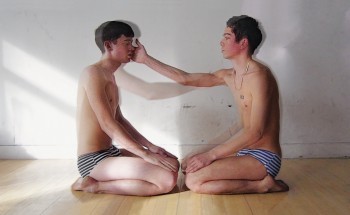

Bros & Brosephines
Slava Mogutin
Preface by Zachary Drucker, Essay by David J. Getsy, Epilogue by Bruce LaBruce, Co-edited and designed by Jan Wandrag
Trim Size: 9-1/2 x 12 Page Count: 192 ISBN: 9781576878248
Over the past two decades, the exiled Russian artist Slava Mogutin has gained international acclaim for his gritty, candid portrayal of disaffected youth and documentation of alternative urban subcultures, as well as his writings, multimedia work, and political activism. Bros & Brosephines is a survey of Mogutin’s studio and fashion photography, commissioned portraits, and previously unpublished images. From his early raw analog snapshots to elaborate compositions, sets, and post-production, the book offers Mogutin’s signature explosive blend of art, fashion, and fetish, transcending and dissecting the conventional notions of beauty and masculinity. The monograph also features Mogutin’s collaborations with fellow artists, including Brian Kenny, Gio Black Peter, Andrey Bartenev, Asher Levine, Martin Elmasflaco, Sebastien Meunier, François Sagat, Jan Wandrag, and many more.
(powerHouse Books)
14 notes
·
View notes
Text
To Each Their Own: A Look at Survey Shows Through the Lens of queer abstraction
To Each Their Own: A Look at Survey Shows Through the Lens of queer abstraction
queer abstractionat the Nerman Museum of Contemporary Art in Overland Park, Kansas is a traveling survey show of queer artists. The complicated nature of doing a show about marginalized identities of any kind is that it inevitably brings societal wounds up to the surface, which are often fresh and ongoing. On the one hand, it’s essential to have the public or mainstream culture aware of these…
View On WordPress
#david getsy#Kemper Museum of Contemporary Art#LGBTQ#matt johnson#Nelson-Atkins Museum of Art#Nerman Museum of Contemporary Art#queer abstraction#queer artists
0 notes
Text
Final
1. Automobile: https://anomiecampbell.tumblr.com/post/187333364807/consider-the-car-as-a-kind-of-human-body-with-the
2. Soft Portrait: Inorganic: https://anomiecampbell.tumblr.com/post/189702114827/1-a-series-of-insular-gestures-transform-the
3. Soft Portrait: Organic: https://anomiecampbell.tumblr.com/post/189702259422/a-piece-of-raw-silk-was-left-outside-for-a-week
4. Soft Portrait: Support, Armature, Pedestal: https://anomiecampbell.tumblr.com/post/189702126532/1-a-cardigan-is-pierced-by-a-twenty-foot-long
5. 1000 Elements: https://anomiecampbell.tumblr.com/post/189702105842/pools-of-sugar-and-cherry-coca-cola-are-mixed-to
6. Object as Sculpture: https://anomiecampbell.tumblr.com/post/189702141892/no-title
7. Forces: https://anomiecampbell.tumblr.com/post/189702099187/1-a-dried-potted-plant-is-carried-around-in-a
8. Immaterial Process: https://anomiecampbell.tumblr.com/post/189702250007/20190710175853
9. Site-Based Sculpture:https://anomiecampbell.tumblr.com/post/189702176597/1-a-performance-score
10. Self-Directed Presentation: https://anomiecampbell.tumblr.com/post/189702196757/1-notes-towards-a-non-comprehensive-theory-of
11. Self-Directed Sculpture: https://anomiecampbell.tumblr.com/post/189702203622/1-a-grafting-of-the-seriality-of-the-quilt
12. Self-Directed Sculpture: https://anomiecampbell.tumblr.com/post/189702212242/1-an-embodiment-of-david-getsys-notion-of-a
13. Self-Directed Sculpture:https://anomiecampbell.tumblr.com/post/189702216607/1-a-second-exploration-of-the-quilt-objects
14. PDF Portfolio: https://drive.google.com/file/d/1ZgldxvjnNV-kikIjdo0R1W9K59c2kQP5/view?usp=sharing
1 note
·
View note
Text
Starting point: What is Queer Art?
My initial interests are to explore queer culture, queer art, queer performance and queer spaces and how working with (queer) participatory arts can influence both those within the spectrum of queer identities as well as those who are not.
Queer as a subject, a theory, an art movement and an identity resonates with me as a lesbian, a feminist and a woman and a self proclaimed ‘leftie snow flake’. Queer to me is an umbrella term for all those who fit into the LGBTQIA+ and beyond as well as those who identify in other ways against the heteronormative, patriarchal standards of our current society and those who haven’t yet found themselves.
The dictionary definition of ‘queer’ as an adjective is “ strange, unusual, or not expected”. Queer as a noun has historically been used as homophobic rhetoric and thus still not universally accepted as an appropriate colloquialism to be used, although to many the reclamation of the word is empowering. Tate Britain’s Queer British Art exhibition explains “Queer has a mixed history – from the 19th century onwards it has been used both as a term of abuse and as a term by LGBT people to refer to themselves. Our inspiration for using it came from Derek Jarman who said that it used to frighten him but now 'for me to use the word queer is a liberation'. More recently, of course, it has become reclaimed as a fluid term for people of different sexualities and gender identities.” (https://www.tate.org.uk/whats-on/tate-britain/exhibition/queer-british-art-1861-1967). Similarly, David Gesty explains “Beginning in the 1980s, "queer" was reappropriated and embraced as a badge of honor.” Mindi Rhoades defines queer as a noun as “an umbrella term encompassing a range of non-heterosexual and transgressive identities.” (Rhoades, Mindi, 2018. LGBTQ Trauma + Art Education). However, Getsy disagrees that queer is an identity itself nor that it equivalates to LGBT categories, but that queer “offers a strategic undercutting of the stability of identity and of the dispensation of power that shadows the assignment of categories and taxonomies.
Queer as a verb, to queer or queering, insinuates change. In ‘Constructing Sexualities and Gendered Bodies in School Spaces’ by Jón Ingvar Kjaran, queer is explained as a verb - “’to queer’ can incorporate the meaning of the verbs; transgress, disrupt, destabilize, interrupt, challenge, trouble and disturb”. He continues “To queer ourselves is to challenge our own limits, to push past our own boundaries, to refuse to accept the common sense and normal for ourselves”. David Getsy explains queer art with a similar use of queer as a verb. He states that “Artists who identify their practices as queer today call forth utopian and dystopian alternatives to the ordinary, adopt outlaw stances, embrace criminality and opacity, and forge unprecedented kinships, relationships, loves, and communities.”

1 note
·
View note